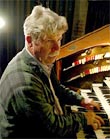|
|
This topic comprises 2 pages: 1 2
|
|
Author
|
Topic: video and/or 16mm capability
|
Scott Norwood
Film God

Posts: 8146
From: Boston, MA. USA (1774.21 miles northeast of Dallas)
Registered: Jun 99
|
 posted 03-28-2004 05:29 PM
posted 03-28-2004 05:29 PM





Random question, I know, but I'm curious.
Does your theatre have permanently installed 16mm and/or video projection capability? What type of equipment do you use? Is the picture and sound quality decent? Do you fill the 35mm screen or project a smaller image? For video, what formats can you play? Do you own the deck(s) or do you just own the projector and rent whatever deck you need when necessary? By "video," I'm not referring to the full-blown DLP setup, just regular NTSC/PAL or HD video.
How often does this equipment get used? Does it pay for itself?
My answer:
Of the three theatres where I work semi-regularly (two singles, one 6-plex), one of them (a single) has 16mm capability, but it's sort of a half-assed setup involving a MARC-300 B&H projector and a separate large-reel unit. I've never run it personally, but they apparently use it a couple of times per year. None of these venues has a permanently installed video system.
The best-equipped places seem to be colleges, which usually have (in addition to 35mm) 16mm and various video formats (mostly DVD, laserdisc, multi-standard VHS, and sometimes 3/4"; I don't know of any place that owns a deck for any of the broadcast formats (Beta SP, Digi-Beta, etc.).
| IP: Logged
|
|
|
|
|
|
|
|
Peter Castle
Expert Film Handler
Posts: 220
From: Wollongong University, NSW ,Australia
Registered: Oct 2003
|
 posted 03-29-2004 04:01 AM
posted 03-29-2004 04:01 AM




Here at Wollongong University, UniMovies, the on-campus film presentation club, has invested quite a lot in video facilities over recent years - there's not a lot of improvement possible on the 35mm side.
We've got a JVC DILA projector (SXGA) outputting 5000 lumens. We use an anamorphic lens on the projector and I feel that the brightness and contrast is sufficient to match our 35mm projectors (we recently updated that to Kineton FP-30E) - but only up to widescreen. We can screen from VHS, SuperVHS, Laserdisc, DVD, VCD and BetaSP as well as miniDV.
We use the projector to screen slides and powerpoint from Mac or PC, and show music videos prior to our 35mm features. If we were not a volunteer organisation I would say the video would not be in any way cost-effective. But we want to be able to support any form of presentation.
Our most recent video presentation was the local Short Film Festival, presented from miniDV. Our screen is 20' high and, although we can project video to full scope ratio, I think widescreen is the biggest picture where video is acceptable.
We'd like to get better resolution input (we can do HD TV). What's the opinion of film-techers of D-VHS as a video source?
Peter Castle
UniMovies
Uni of Wollongong
| IP: Logged
|
|
|
|
Daniel Alt
Expert Film Handler

Posts: 111
From: Lakewood, OH, USA
Registered: Mar 2004
|
 posted 03-29-2004 11:07 AM
posted 03-29-2004 11:07 AM




Don't know the model of our projector off the top of my head, but the CWRU film society has a permanantly installed 16 projector. The manual's in Italian, if that helps. Vertically it fills the screen, and it has a turret with standard and anamorphic lenses. (Last anamorphic 16 print we showed was the original Solaris, which I thought was boring as heck, but that's another thread)
We also have a pair of portiable EIKIs we use when we the university decides they need to use the room for other purposes. Fortunately, that's extremely rare.
No permanantly installed video capability, but we can borrow a projector when we get a completely unrunnable print and have to go rent the DVD to show. (Which we then retroactively go and sort out with our distributor. We paid for the right to show the movie, after all.) It looks like garbage, though. Rocky Horror with a live cast and a DVD? Yuk.
| IP: Logged
|
|
|
|
|
|
Mike Olpin
Chop Chop!

Posts: 1852
From: Dallas, TX
Registered: Jan 2002
|
 posted 03-29-2004 08:09 PM
posted 03-29-2004 08:09 PM




Almost all Regal theatres have permanently intalled video projectors in every auditorium for preshow advertising, live satalite events, and content for buisiness auditorium rentals.
The video source is primarily from a computer playing higher-than-dvd quality MPEG, allthough any source with VGA, s-video, or component video out can also be used.
The video is projected using a Christie Road Runner L6 DLP projector, which is really an aftermarket Sanyo. We also use the lense attachment to achieve better throw. Typicly the video fills the entire screen, but not always. The color and video quality depends on how big the screen is. This projector works extreamly well on screens up to 30 feet wide, with excellent color. However beyond 30 feet, the image begins to get dim.
| IP: Logged
|
|
|
|
|
|
|
|
John Pytlak
Film God

Posts: 9987
From: Rochester, NY 14650-1922
Registered: Jan 2000
|
 posted 03-29-2004 10:27 PM
posted 03-29-2004 10:27 PM





Small world...Sanyo is one of Kodak's partners in commercializing Organic Light Emitting Diode (OLED) displays:
http://www.kodak.com/US/en/corp/display/sanyoFlat.jhtml
quote:
Eastman Kodak Company and Sanyo Electric Co. unveiled this week a prototype fifteen-inch flat-panel display, the next generation of full-color displays based on Kodak's patented organic light-emitting diode (OLED) technology.
The two companies are showing the prototype at the CEATEC JAPAN trade show. The active-matrix display features full-color, 1280 x 720 (HDTV) resolution; a display area of 326.4 x 183.6 mm; and a brightness that rivals the best active-matrix LCD monitors on the market today.
http://www.kodak.com/US/en/corp/display/LS633.jhtml
quote:
OLED Technology
OLED displays comprise self-luminous pixels, requiring no backlights used in liquid crystal displays (LCDs). So they offer design and performance advantages, including clearer images, crisper video, and thinner designs in digital cameras, mobile phones, PDAs and other devices. Additional benefits over conventional technologies include higher contrast for superb readability in most lighting conditions, faster response time to support streaming video, and industry-leading (165 degree) viewing angle for superior ergonomics. In addition to the joint manufacturing venture for AM OLED panels with Sanyo, Kodak licenses OLED technology to more than one dozen display and device manufacturers worldwide.
| IP: Logged
|
|
|
|
|
|
All times are Central (GMT -6:00)
|
This topic comprises 2 pages: 1 2
|
Powered by Infopop Corporation
UBB.classicTM
6.3.1.2
The Film-Tech Forums are designed for various members related to the cinema industry to express their opinions, viewpoints and testimonials on various products, services and events based upon speculation, personal knowledge and factual information through use, therefore all views represented here allow no liability upon the publishers of this web site and the owners of said views assume no liability for any ill will resulting from these postings. The posts made here are for educational as well as entertainment purposes and as such anyone viewing this portion of the website must accept these views as statements of the author of that opinion
and agrees to release the authors from any and all liability.
|

 Home
Home
 Products
Products
 Store
Store
 Forum
Forum
 Warehouse
Warehouse
 Contact Us
Contact Us




 Printer-friendly view of this topic
Printer-friendly view of this topic


















